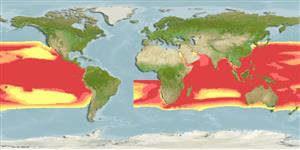Common names from other countries
>
Beloniformes (Needle fishes) >
Hemiramphidae (Halfbeaks)
Etymology: Euleptorhamphus: Greek, eu = good + Greek, leptos = thin + greek, rhamphos = bill, peak (Ref. 45335).
Environment: milieu / climate zone / depth range / distribution range
Ecologia
marinhas; oceanódromo (Ref. 51243); intervalo de profundidade 0 - 1 m (Ref. 58302). Subtropical
Indo-Pacific: Red Sea and East Africa to Hawaii (Ref. 583) and Tonga, north to southern Japan, south to Australia, New Zealand and Kermadec Islands (Ref. 8879). Eastern Pacific: southern California, USA to Ecuador, including the Galapagos Islands (Ref. 2850).
Length at first maturity / Tamanho / Peso / Idade
Maturity: Lm ?, range 25 - ? cm
Max length : 53.0 cm TL macho/indeterminado; (Ref. 55763); common length : 30.0 cm SL macho/indeterminado; (Ref. 9306)
Espinhos dorsais (total): 0; Raios dorsais moles (total): 21-25; Espinhos anais 0; Raios anais moles: 20 - 25; Vértebras: 70 - 75. Body very elongate; lower jaw very prolonged; upper jaw short, triangular, and scaly; teeth present on vomer and tongue; dorsal fin with 22 to 25 rays; anal fin with 22 to 24 rays; pectoral fins long, with 8 or 9 rays; back iridescent blue green; belly silvery (Ref. 55763). Fins unpigmented (Ref. 4164).
Usually oceanic but enters large open bays (Ref. 2850). Found around islands (Ref. 9306). Capable of jumping out of the water and gliding above the surface (Ref. 9306).
Life cycle and mating behavior
Maturidade | Reprodução | Desova | Ovos | Fecundidade | Larvas
Collette, B.B. and J. Su, 1986. The halfbeaks (Pisces, Beloniformes, Hemiramphidae) of the Far East. Proc. Acad. Nat. Sci. Philadelphia 138(1):250-301. (Ref. 10943)
Categoria na Lista Vermelha da IUCN (Ref. 130435)
CITES (Ref. 128078)
Not Evaluated
Ameaça para o homem
Harmless
Utilização humana
Pescarias: pouco comercial
Mais informação
ReferênciasAquaculturaPerfil para aquaculturaEstirpesGenéticaElectrophoresesHereditariedadeDoençasProcessamentoMass conversion
Ferramentas
Relatórios especiais
Descarregue XML
Fontes da internet
Estimates based on models
Preferred temperature (Ref.
115969): 20.2 - 29.2, mean 26.9 (based on 43417 cells).
Phylogenetic diversity index (Ref.
82804): PD
50 = 0.7500 [Uniqueness, from 0.5 = low to 2.0 = high].
Bayesian length-weight: a=0.00102 (0.00046 - 0.00225), b=3.06 (2.88 - 3.24), in cm Total Length, based on all LWR estimates for this body shape (Ref.
93245).
Nível Trófico (Ref.
69278): 3.4 ±0.45 se; based on food items.
Resiliência (Ref.
120179): Elevada, tempo mínimo de duplicação da população menor que 15 meses (Preliminary K or Fecundity.).
Fishing Vulnerability (Ref.
59153): Moderate vulnerability (41 of 100).
